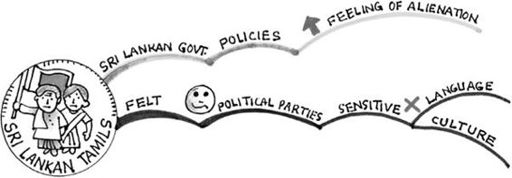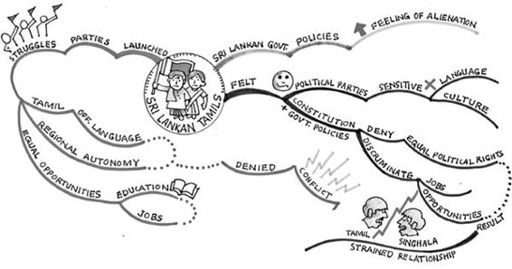How to Memorize Anything (37 page)
Read How to Memorize Anything Online
Authors: Aditi Singhal,Sudhir Singhal
Tags: #Self-Help, #Meditations


When you question the material, you engage your mind and prepare it for learning. You’re far more likely to retain information when you’re actively looking for it.
3. READ:
You should read through the related material, focusing on the information that best relates to the questions formulated earlier.
For example:
If I am reading about a war, I will ask questions like
When? Where? Why? Between whom?etc.
Now while reading the text, you must answer these questions before moving on. This way your complete concentration will be on the text that you are reading.
Do some underlining or highlighting of key words. Don’t overdo it! If you want to take notes, read the whole section first, and then summarize it later.
4. SUMMARIZE:
The student summarizes the topic, bringing his or her own understanding into the process. Using key word or phrases, one is meant to identify major points and answers to questions from the questioning step. This may include
written notes, spider diagrams, flow diagrams, mind maps®, labelled diagrams, mnemonics, or even voice recordings.
Check back against the text, and note the things you missed out.
An example of summarizing a topic through a mind map is demonstrated in the next section of mind mapping your notes.
5. TEST:
So now you have finished the chapter (or a major section if the chapter contains large dissimilar sections). Test yourself and answer the questions drafted earlier, avoiding adding any questions that might distract or change the subject. Review all the material. If you made notes, read through these. Think about the relevance of what you learnt and how it all fits together. Reread any chapter summaries. Even though you have only just read the chapter, now is the
best
time to test yourself.

Researchers have tested this method and found it really helpful in improving readers understanding, and his/her ability to recall information. Summarizing is particularly effective if done properly, as is the questioning step. After all, this makes sense because it is putting your brain into gear and warming it up before you start.
MIND MAP YOUR NOTES
WHY SHOULD ONE TAKE NOTES?
Note-taking activity is one of the most crucial parts of learning. Taking effective notes during lectures or reading helps you to concentrate, stimulates your ability to recall, and helps you to be organized.
Students many a times think it is a boring and time-consuming activity and therefore revise directly from the textbook. However, if we have quality notes, we can save our time in revision and can in fact revise more number of times in the same duration as revising directly from the book.
Note taking helps students in:
- Extending their attention spans and keeps them focused.
- Learning more effectively by using both listening and writing skills.
- Selecting important material and discarding unimportant material.
- Changing from passive learners to active learners.
- Organizing the ideas they are learning.
Differences between note taking in lectures and when reading
The big difference between note taking in lectures and note taking from reading is that in lectures, you can’t slow down or pause the lecturer if you fall behind your note taking. So, for taking notes we need to follow some strategies:
TAKING NOTES IN LECTURES
- Think about the subject of the lecture beforehand so as to grasp the ideas quickly.
- Concentrate on the ‘big picture’ in a lecture and do not try to write everything down.
- Keep your notes brief—long notes do not help your understanding of the lecture at all.
- Use your own abbreviations.
- Make keywords stand out—underline, capitals.
TAKING NOTES FROM READING
- Before you start reading, identify the purpose of reading.
- Use your own words, wherever possible, to help understanding.
- Break down the note taking task by asking specific questions:
- What questions you want to answer with this information?
- Have you noted similar information already?
- Any specific information? Names and dates?
- What questions you want to answer with this information?
- Include references (page numbers, etc. for checking back)
CREATING MAP OF NOTES – MIND MAPS
In this stage of creative note taking, we write notes in radiant format by using symbols and images, wherever possible, along with the keywords. This technique is popularly known as
Mind Maps
®
,
invented by
Tony Buzan
.
It is a graphical technique that mirrors the way the brain works. The subject of interest is crystallized in a central image and then the main themes radiate out from the central image on branches. Each branch holds a key image or key word printed on the line. Details are added to the main branches and radiate out.
Most people’s notes are on lined paper using blue or black ink which looks extremely boring. To make your notes more attractive to your brain,
add colour, rhythm, and imagination
and all of a sudden taking notes becomes much more fun.
Make creative notes for quick revision as explained in the chapter ‘
Mind Maps—Creative Note Taking
’. Here is an example of creating a mind map® step-by-step for a given long answer:
Q. What are the effects of the policy of Sri Lanka on Sri Lankan Tamils?
Ans.
The government measures, coming one after the other, gradually increased the feeling of alienation among the Sri Lankan Tamils. They felt that none of the major political parties led by the Buddhist Sinhala leaders were sensitive to their language and culture. They felt that the constitution and government policies denied them equal political rights, discriminated against them in getting jobs and other opportunities and ignored their interests. As a result, the relations between the Sinhala and Tamil communities strained over times. The Sri LankanTamils launched parties and struggled for the recognition of Tamil as an official language, for regional autonomy and equality of opportunity in securing education and jobs. But their demand was repeatedly denied. By the 1980s, several political organizations were formed demanding an independent Tamil Elam in northern and eastern parts of Sri Lanka. The distrust between twocommunities turned into widespread conflict. It soon turned into a civil war. As a result thousands of people of both the communities have been killed. Many families were forced to leave the country as refugees and many more lost their livelihoods.
To make a mind map of this answer, first convert this whole paragraph into points and then identify the key words from each point. Using those keywords, make a mind map systematically, putting along appropriate images as explained step by step in the next few pages:
Q. What are the effects of the policy of Sri Lanka?
Ans.:
- The
government measures
, coming one after the other, gradually
increased
the
feeling of alienation
among the Sri Lankan Tamils.
- They
felt
that
none
of the major
political parties
led by the Buddhist Sinhala leaders were
sensitive
to their
language
and
culture
.
- They felt that the
constitution and government policies denied
them
equal political rights, discriminated
against them in getting
jobs
and other
opportunities
and ignored their interests. - As a
result
, the
relations
between the Sinhala and Tamil communities
strained
over times.
- The Sri Lankan Tamils
launched parties
and
struggled
for the recognition of
Tamil
as an
official language
, for
regional autonomy
and
equality
of
opportunity
in securing
education
and
jobs
. But their demand was repeatedly
denied
.

